Dental Technology Student Survey
VerifiedAdded on 2020/06/04
|23
|4181
|176
AI Summary
This assignment delves into the perceptions of dental students regarding digital assessment software used in preclinical tooth preparation exercises. It requires a critical analysis of published research papers exploring various aspects of digital technology integration in dental education, focusing on student experiences and attitudes towards CAD/CAM systems, virtual reality applications, and impression techniques. Students are expected to synthesize information from these sources to understand the evolving landscape of dental education and the impact of digital tools on learning outcomes.
Contribute Materials
Your contribution can guide someone’s learning journey. Share your
documents today.
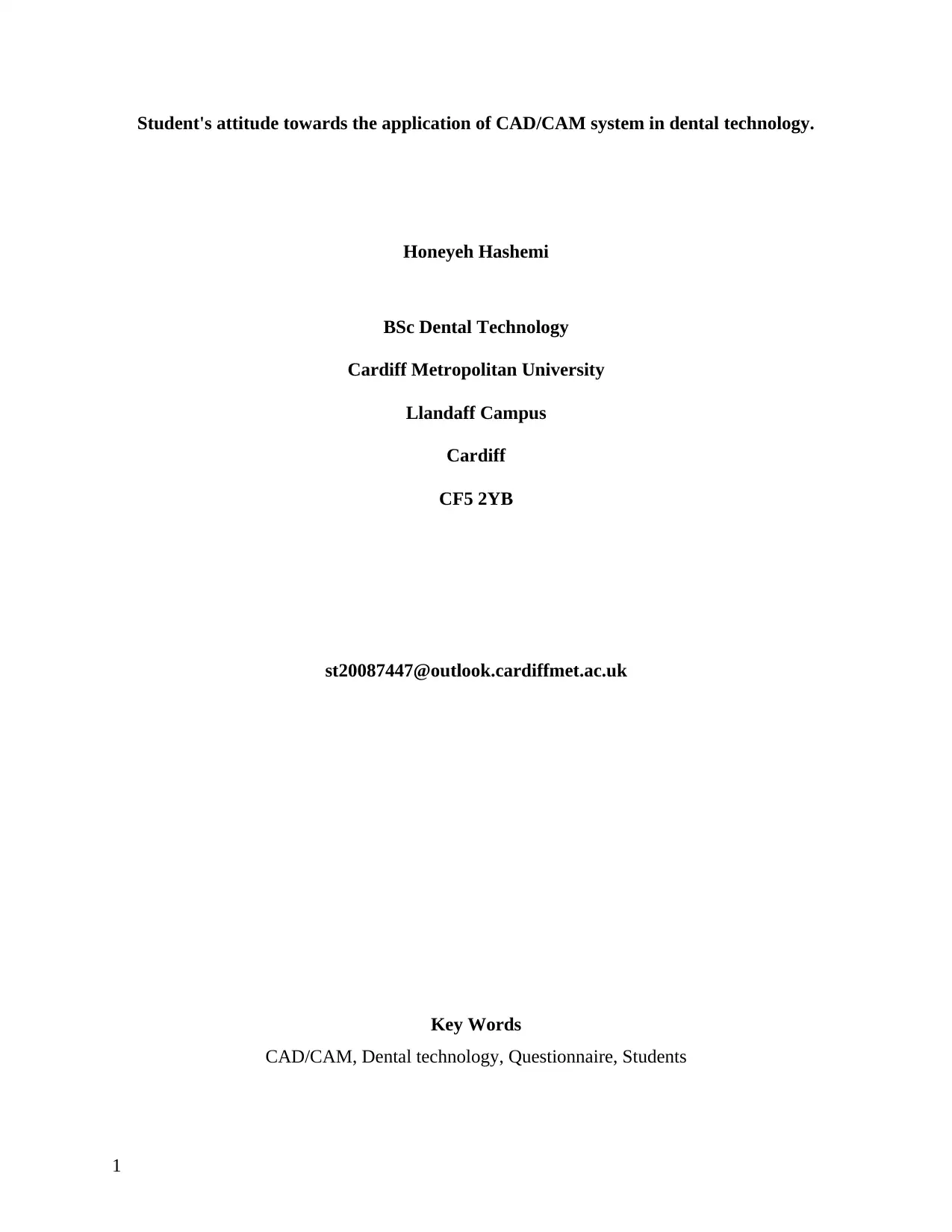
Student's attitude towards the application of CAD/CAM system in dental technology.
Honeyeh Hashemi
BSc Dental Technology
Cardiff Metropolitan University
Llandaff Campus
Cardiff
CF5 2YB
st20087447@outlook.cardiffmet.ac.uk
Key Words
CAD/CAM, Dental technology, Questionnaire, Students
1
Honeyeh Hashemi
BSc Dental Technology
Cardiff Metropolitan University
Llandaff Campus
Cardiff
CF5 2YB
st20087447@outlook.cardiffmet.ac.uk
Key Words
CAD/CAM, Dental technology, Questionnaire, Students
1
Secure Best Marks with AI Grader
Need help grading? Try our AI Grader for instant feedback on your assignments.
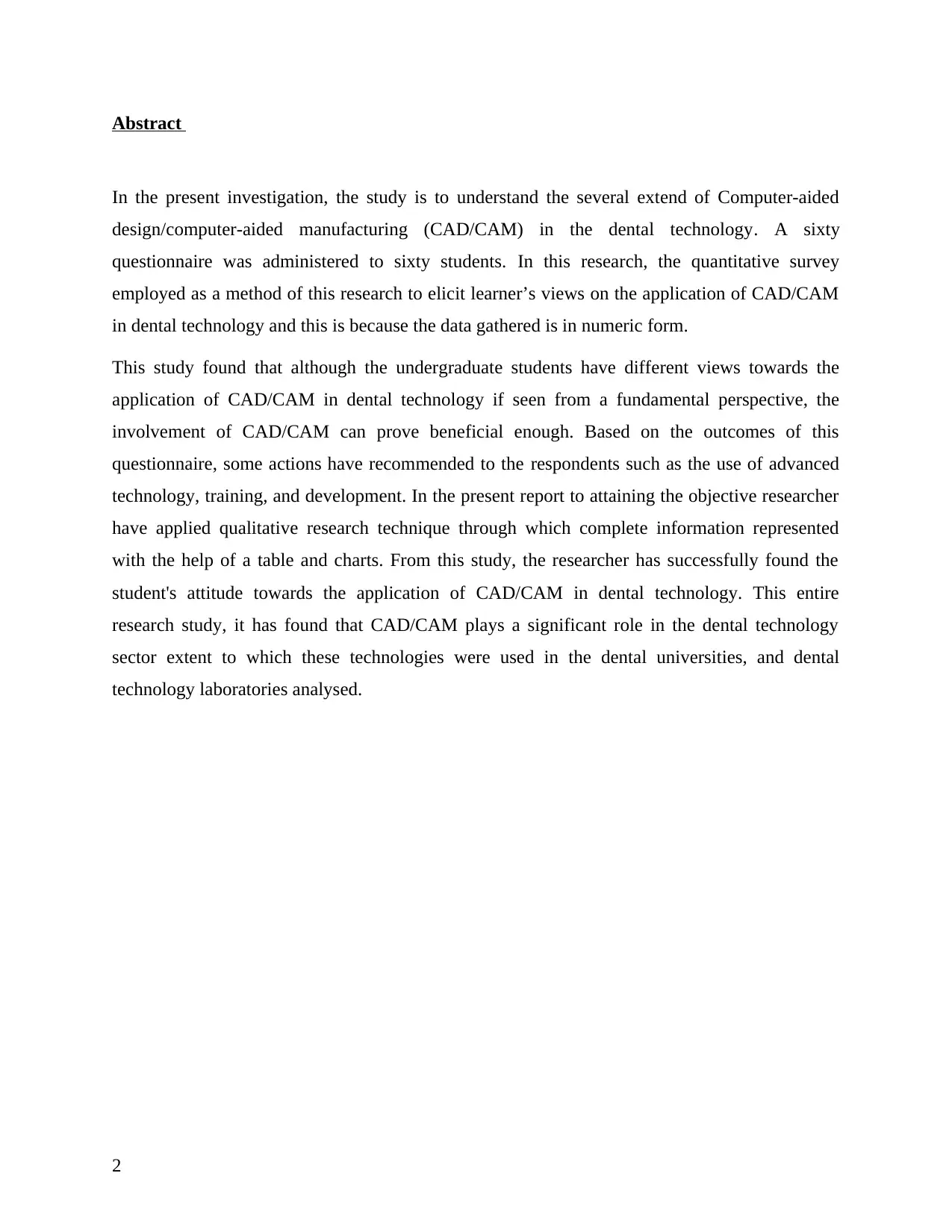
Abstract
In the present investigation, the study is to understand the several extend of Computer-aided
design/computer-aided manufacturing (CAD/CAM) in the dental technology. A sixty
questionnaire was administered to sixty students. In this research, the quantitative survey
employed as a method of this research to elicit learner’s views on the application of CAD/CAM
in dental technology and this is because the data gathered is in numeric form.
This study found that although the undergraduate students have different views towards the
application of CAD/CAM in dental technology if seen from a fundamental perspective, the
involvement of CAD/CAM can prove beneficial enough. Based on the outcomes of this
questionnaire, some actions have recommended to the respondents such as the use of advanced
technology, training, and development. In the present report to attaining the objective researcher
have applied qualitative research technique through which complete information represented
with the help of a table and charts. From this study, the researcher has successfully found the
student's attitude towards the application of CAD/CAM in dental technology. This entire
research study, it has found that CAD/CAM plays a significant role in the dental technology
sector extent to which these technologies were used in the dental universities, and dental
technology laboratories analysed.
2
In the present investigation, the study is to understand the several extend of Computer-aided
design/computer-aided manufacturing (CAD/CAM) in the dental technology. A sixty
questionnaire was administered to sixty students. In this research, the quantitative survey
employed as a method of this research to elicit learner’s views on the application of CAD/CAM
in dental technology and this is because the data gathered is in numeric form.
This study found that although the undergraduate students have different views towards the
application of CAD/CAM in dental technology if seen from a fundamental perspective, the
involvement of CAD/CAM can prove beneficial enough. Based on the outcomes of this
questionnaire, some actions have recommended to the respondents such as the use of advanced
technology, training, and development. In the present report to attaining the objective researcher
have applied qualitative research technique through which complete information represented
with the help of a table and charts. From this study, the researcher has successfully found the
student's attitude towards the application of CAD/CAM in dental technology. This entire
research study, it has found that CAD/CAM plays a significant role in the dental technology
sector extent to which these technologies were used in the dental universities, and dental
technology laboratories analysed.
2

Introduction
Aim
In the present investigation, the study is to understand the several extend of Computer-
aided design/computer-aided manufacturing (CAD/CAM) in the dental technology.
Methods
In this research, qualitative survey has been employed as a method to carry out this
research to elicit learner’s views on the application of CAD/CAM in dental technology and this
is because the data gathered is in numeric form.
Result and discussion
This study found that although the undergraduate students have different views towards
the application of CAD/CAM in dental technology if seen from a fundamental perspective, the
involvement of CAD/CAM can prove beneficial enough. From the outcomes, it can conclude
that CAD/CAM plays a significant role in dentistry and dental technology sector. From this
study, the researcher has successfully identified the student's attitude towards the application of
CAD/CAM in dental technology. There are several kinds of the limitation found related to the
application of CAD/CAM such as lack of proper resources, lack of technology and unskilled
employees. From this entire research study, it has found that CAD/CAM plays a significant role
in the dentistry technology sector extent to which these technologies are being used in the dental
universities, and dental technology laboratories analysed.
As per Alghazzawi (2016) Technological advancements have provided flexible ways in dental
technology which have improved dental technology and reduced patients’ pain. Digital dentistry
offers dental technicians a variety of options in fabricating aesthetically devices such as tools
used in dentistry. CAD/CAM system shorten the working process and suggest safer and secure
treatment for patients (Sabalic and Schoener, 2017). Furthermore, the significance of the using
CAD/CAM in dental technology discussed in this report. The researcher can get the detail
knowledge and understanding of the various extent of CAD/CAM in the dental technology in
this research study.
3
Aim
In the present investigation, the study is to understand the several extend of Computer-
aided design/computer-aided manufacturing (CAD/CAM) in the dental technology.
Methods
In this research, qualitative survey has been employed as a method to carry out this
research to elicit learner’s views on the application of CAD/CAM in dental technology and this
is because the data gathered is in numeric form.
Result and discussion
This study found that although the undergraduate students have different views towards
the application of CAD/CAM in dental technology if seen from a fundamental perspective, the
involvement of CAD/CAM can prove beneficial enough. From the outcomes, it can conclude
that CAD/CAM plays a significant role in dentistry and dental technology sector. From this
study, the researcher has successfully identified the student's attitude towards the application of
CAD/CAM in dental technology. There are several kinds of the limitation found related to the
application of CAD/CAM such as lack of proper resources, lack of technology and unskilled
employees. From this entire research study, it has found that CAD/CAM plays a significant role
in the dentistry technology sector extent to which these technologies are being used in the dental
universities, and dental technology laboratories analysed.
As per Alghazzawi (2016) Technological advancements have provided flexible ways in dental
technology which have improved dental technology and reduced patients’ pain. Digital dentistry
offers dental technicians a variety of options in fabricating aesthetically devices such as tools
used in dentistry. CAD/CAM system shorten the working process and suggest safer and secure
treatment for patients (Sabalic and Schoener, 2017). Furthermore, the significance of the using
CAD/CAM in dental technology discussed in this report. The researcher can get the detail
knowledge and understanding of the various extent of CAD/CAM in the dental technology in
this research study.
3
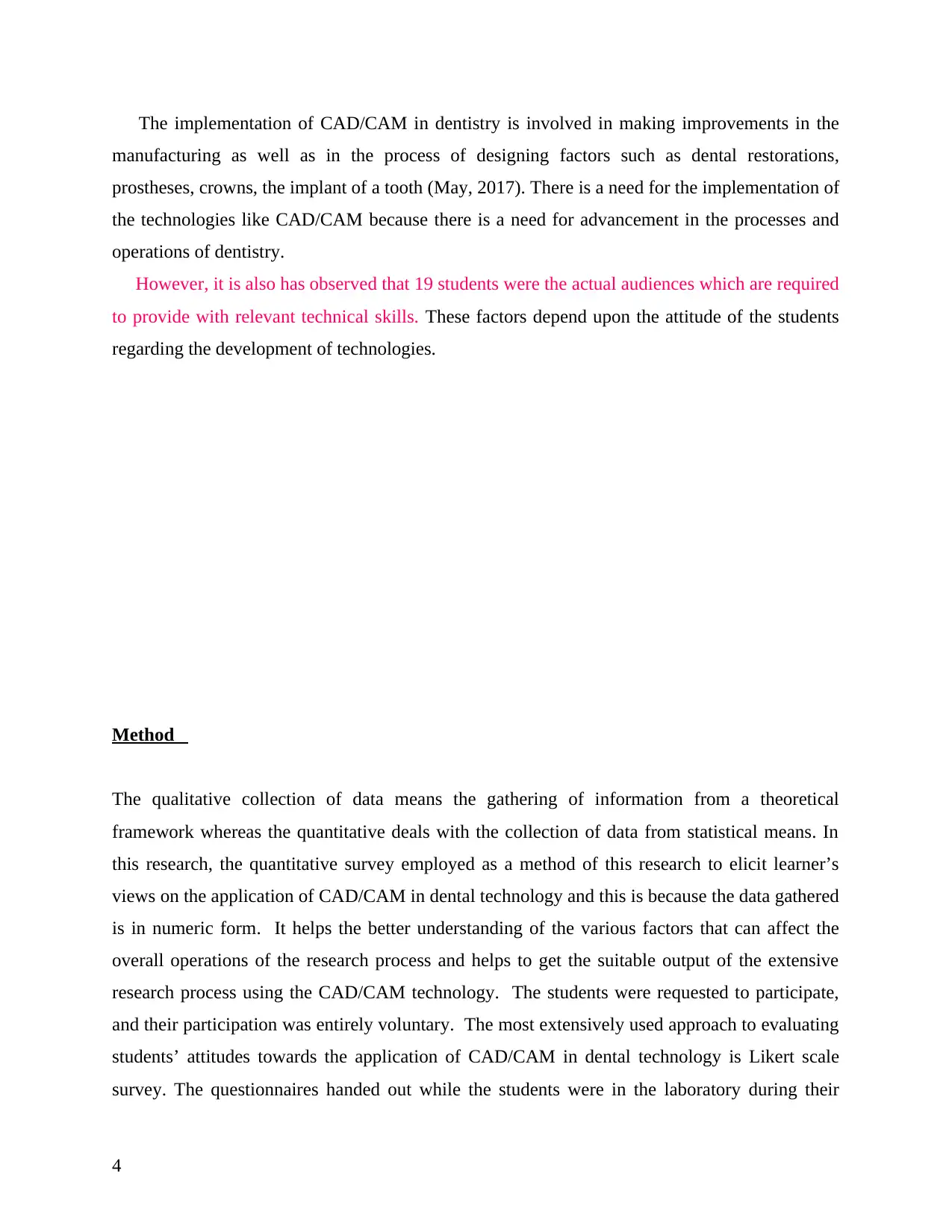
The implementation of CAD/CAM in dentistry is involved in making improvements in the
manufacturing as well as in the process of designing factors such as dental restorations,
prostheses, crowns, the implant of a tooth (May, 2017). There is a need for the implementation of
the technologies like CAD/CAM because there is a need for advancement in the processes and
operations of dentistry.
However, it is also has observed that 19 students were the actual audiences which are required
to provide with relevant technical skills. These factors depend upon the attitude of the students
regarding the development of technologies.
Method
The qualitative collection of data means the gathering of information from a theoretical
framework whereas the quantitative deals with the collection of data from statistical means. In
this research, the quantitative survey employed as a method of this research to elicit learner’s
views on the application of CAD/CAM in dental technology and this is because the data gathered
is in numeric form. It helps the better understanding of the various factors that can affect the
overall operations of the research process and helps to get the suitable output of the extensive
research process using the CAD/CAM technology. The students were requested to participate,
and their participation was entirely voluntary. The most extensively used approach to evaluating
students’ attitudes towards the application of CAD/CAM in dental technology is Likert scale
survey. The questionnaires handed out while the students were in the laboratory during their
4
manufacturing as well as in the process of designing factors such as dental restorations,
prostheses, crowns, the implant of a tooth (May, 2017). There is a need for the implementation of
the technologies like CAD/CAM because there is a need for advancement in the processes and
operations of dentistry.
However, it is also has observed that 19 students were the actual audiences which are required
to provide with relevant technical skills. These factors depend upon the attitude of the students
regarding the development of technologies.
Method
The qualitative collection of data means the gathering of information from a theoretical
framework whereas the quantitative deals with the collection of data from statistical means. In
this research, the quantitative survey employed as a method of this research to elicit learner’s
views on the application of CAD/CAM in dental technology and this is because the data gathered
is in numeric form. It helps the better understanding of the various factors that can affect the
overall operations of the research process and helps to get the suitable output of the extensive
research process using the CAD/CAM technology. The students were requested to participate,
and their participation was entirely voluntary. The most extensively used approach to evaluating
students’ attitudes towards the application of CAD/CAM in dental technology is Likert scale
survey. The questionnaires handed out while the students were in the laboratory during their
4
Secure Best Marks with AI Grader
Need help grading? Try our AI Grader for instant feedback on your assignments.
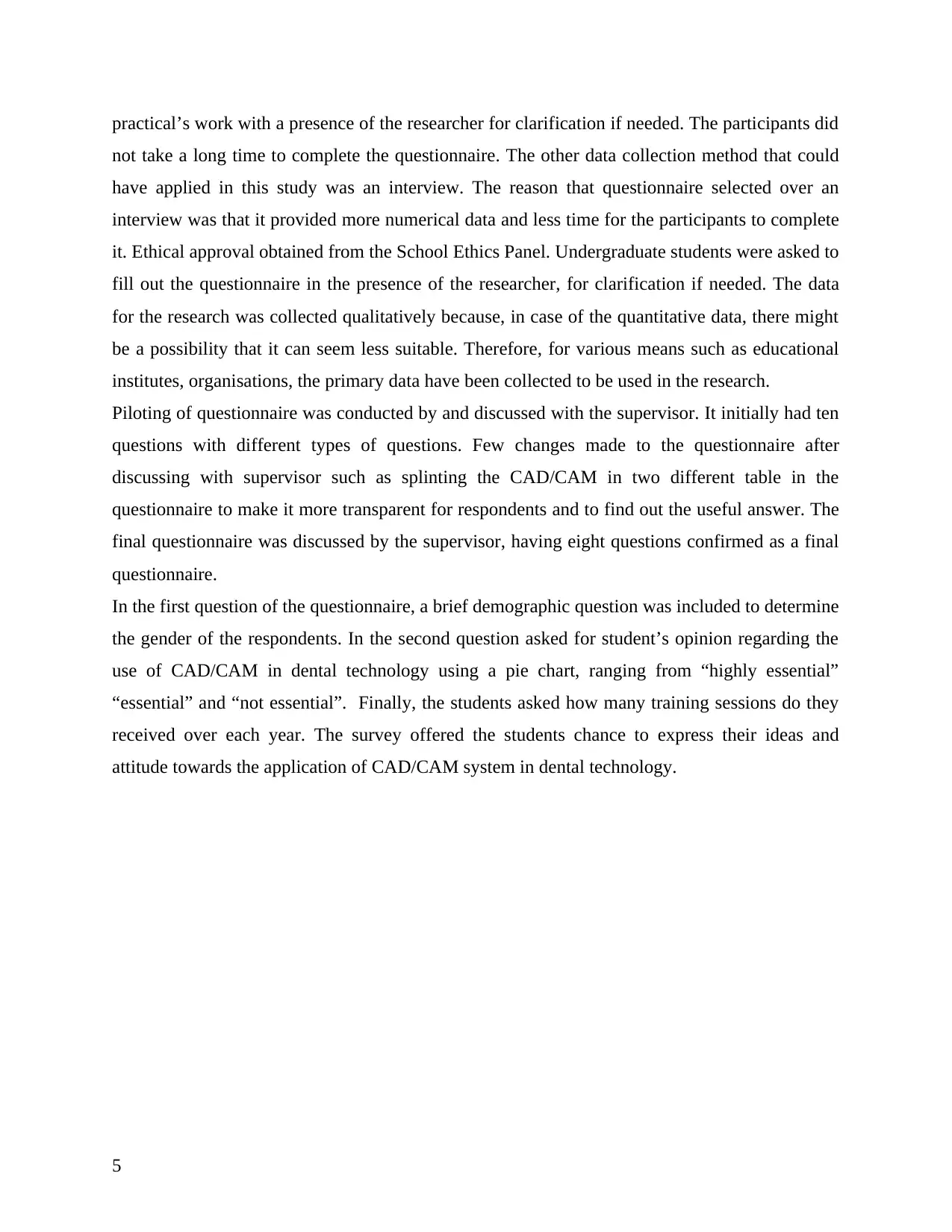
practical’s work with a presence of the researcher for clarification if needed. The participants did
not take a long time to complete the questionnaire. The other data collection method that could
have applied in this study was an interview. The reason that questionnaire selected over an
interview was that it provided more numerical data and less time for the participants to complete
it. Ethical approval obtained from the School Ethics Panel. Undergraduate students were asked to
fill out the questionnaire in the presence of the researcher, for clarification if needed. The data
for the research was collected qualitatively because, in case of the quantitative data, there might
be a possibility that it can seem less suitable. Therefore, for various means such as educational
institutes, organisations, the primary data have been collected to be used in the research.
Piloting of questionnaire was conducted by and discussed with the supervisor. It initially had ten
questions with different types of questions. Few changes made to the questionnaire after
discussing with supervisor such as splinting the CAD/CAM in two different table in the
questionnaire to make it more transparent for respondents and to find out the useful answer. The
final questionnaire was discussed by the supervisor, having eight questions confirmed as a final
questionnaire.
In the first question of the questionnaire, a brief demographic question was included to determine
the gender of the respondents. In the second question asked for student’s opinion regarding the
use of CAD/CAM in dental technology using a pie chart, ranging from “highly essential”
“essential” and “not essential”. Finally, the students asked how many training sessions do they
received over each year. The survey offered the students chance to express their ideas and
attitude towards the application of CAD/CAM system in dental technology.
5
not take a long time to complete the questionnaire. The other data collection method that could
have applied in this study was an interview. The reason that questionnaire selected over an
interview was that it provided more numerical data and less time for the participants to complete
it. Ethical approval obtained from the School Ethics Panel. Undergraduate students were asked to
fill out the questionnaire in the presence of the researcher, for clarification if needed. The data
for the research was collected qualitatively because, in case of the quantitative data, there might
be a possibility that it can seem less suitable. Therefore, for various means such as educational
institutes, organisations, the primary data have been collected to be used in the research.
Piloting of questionnaire was conducted by and discussed with the supervisor. It initially had ten
questions with different types of questions. Few changes made to the questionnaire after
discussing with supervisor such as splinting the CAD/CAM in two different table in the
questionnaire to make it more transparent for respondents and to find out the useful answer. The
final questionnaire was discussed by the supervisor, having eight questions confirmed as a final
questionnaire.
In the first question of the questionnaire, a brief demographic question was included to determine
the gender of the respondents. In the second question asked for student’s opinion regarding the
use of CAD/CAM in dental technology using a pie chart, ranging from “highly essential”
“essential” and “not essential”. Finally, the students asked how many training sessions do they
received over each year. The survey offered the students chance to express their ideas and
attitude towards the application of CAD/CAM system in dental technology.
5

Results
The relevant information was gathered, a questionnaire conducted, and 60 students took part in
this activity. This evaluation helped to identify the attitude of students regarding the
implementation of CAD/CAM system in dental technology. From the outcomes of the survey, it
has analysed that only seven students who are highly satisfied with the appropriateness of the
training that conducted for the development of technologies. However, it should recognise that
18 respondents are satisfied with the training.
Below is a thematic analysis along with interpretation of the questions that asked in the
questionnaire:
Table 1
6
The relevant information was gathered, a questionnaire conducted, and 60 students took part in
this activity. This evaluation helped to identify the attitude of students regarding the
implementation of CAD/CAM system in dental technology. From the outcomes of the survey, it
has analysed that only seven students who are highly satisfied with the appropriateness of the
training that conducted for the development of technologies. However, it should recognise that
18 respondents are satisfied with the training.
Below is a thematic analysis along with interpretation of the questions that asked in the
questionnaire:
Table 1
6

Demographic factor: Gender Number of Respondents
Male 14
Female 46
The demographic information gathered is presented in Table 1. It shows that 76% of the samples
were female and 24% male.
Table 2:
Need of CAD/CAM technologies in the
sector.
Number of Respondents
What is your opinion regarding the use of
CAD in dental technology?
Highly essential 30.00%
Essential 50.00%
Not essential 20.00%
7
Male 14
Female 46
The demographic information gathered is presented in Table 1. It shows that 76% of the samples
were female and 24% male.
Table 2:
Need of CAD/CAM technologies in the
sector.
Number of Respondents
What is your opinion regarding the use of
CAD in dental technology?
Highly essential 30.00%
Essential 50.00%
Not essential 20.00%
7
Paraphrase This Document
Need a fresh take? Get an instant paraphrase of this document with our AI Paraphraser

From the outcomes that were obtained from the students, it has observed that 18 students believe
that the knowledge of CAD/CAM technologies was highly essential for their development and
should include in the course. Besides this, 50% students think that there is no need of involving
CAD/CAM technologies in their practices. On the other hand, there are also some people who
believe that these involvements are not at all essential.
Table 3:
How much time is spent learning basics of
CAD and CAM?
Number of Respondents
How many hours do you spend on developing
CAD basics?
More than 2 hours 10
1-2 hours 18
Less than 1 hour 22
No time 10
How many hours do you spend on developing
CAM basics?
More than 2 hours 8
1-2 hours 20
Less than 1 hour 22
No time 10
8
that the knowledge of CAD/CAM technologies was highly essential for their development and
should include in the course. Besides this, 50% students think that there is no need of involving
CAD/CAM technologies in their practices. On the other hand, there are also some people who
believe that these involvements are not at all essential.
Table 3:
How much time is spent learning basics of
CAD and CAM?
Number of Respondents
How many hours do you spend on developing
CAD basics?
More than 2 hours 10
1-2 hours 18
Less than 1 hour 22
No time 10
How many hours do you spend on developing
CAM basics?
More than 2 hours 8
1-2 hours 20
Less than 1 hour 22
No time 10
8
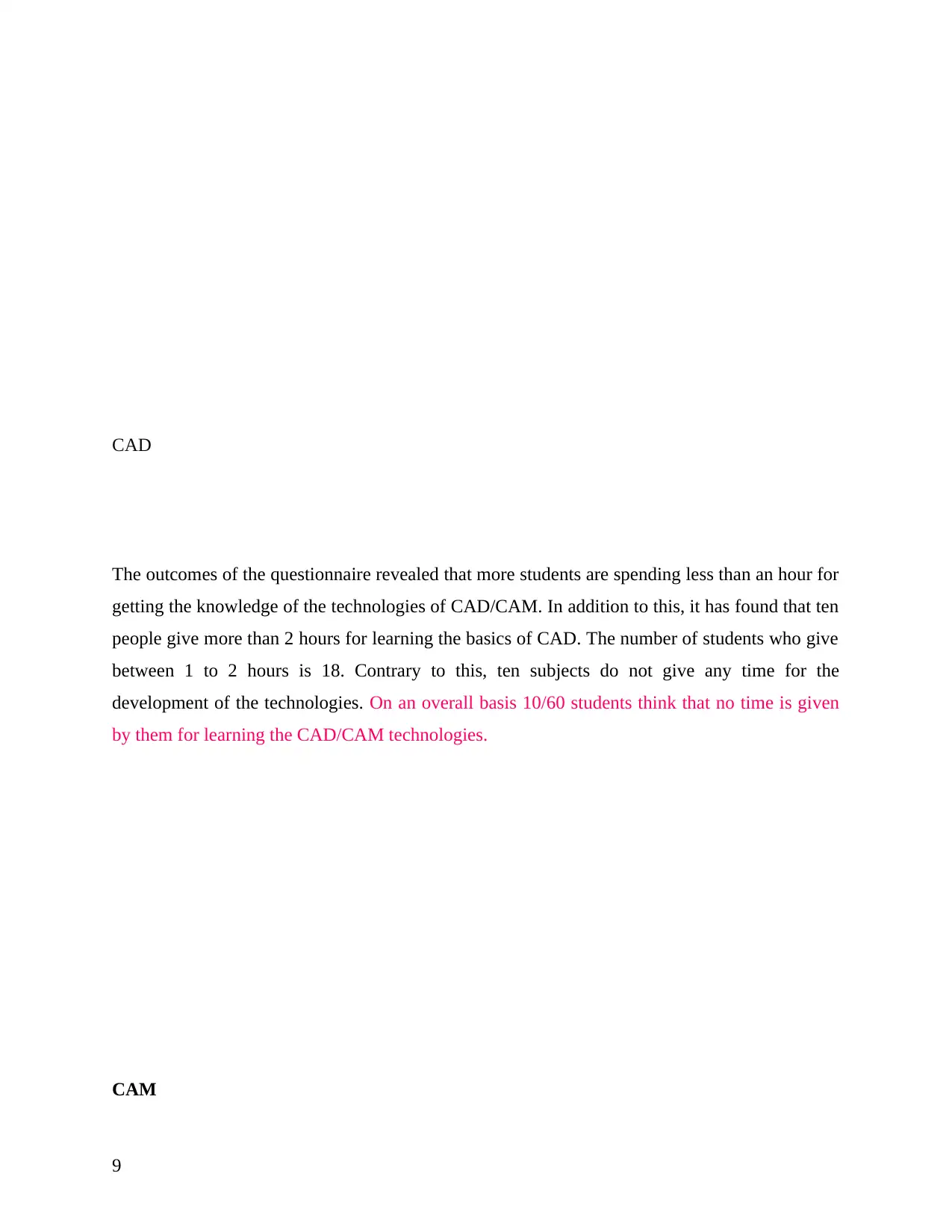
CAD
The outcomes of the questionnaire revealed that more students are spending less than an hour for
getting the knowledge of the technologies of CAD/CAM. In addition to this, it has found that ten
people give more than 2 hours for learning the basics of CAD. The number of students who give
between 1 to 2 hours is 18. Contrary to this, ten subjects do not give any time for the
development of the technologies. On an overall basis 10/60 students think that no time is given
by them for learning the CAD/CAM technologies.
CAM
9
The outcomes of the questionnaire revealed that more students are spending less than an hour for
getting the knowledge of the technologies of CAD/CAM. In addition to this, it has found that ten
people give more than 2 hours for learning the basics of CAD. The number of students who give
between 1 to 2 hours is 18. Contrary to this, ten subjects do not give any time for the
development of the technologies. On an overall basis 10/60 students think that no time is given
by them for learning the CAD/CAM technologies.
CAM
9
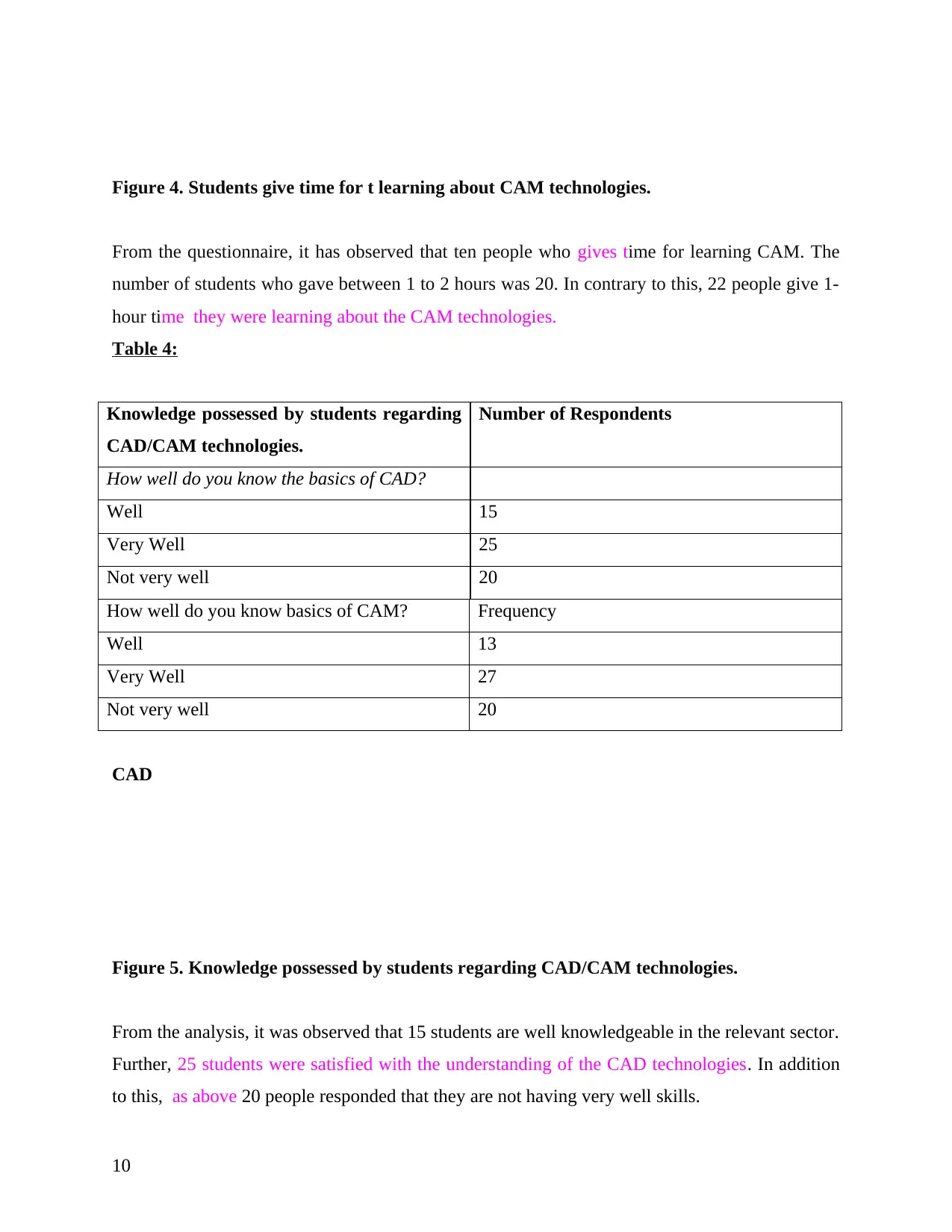
Figure 4. Students give time for t learning about CAM technologies.
From the questionnaire, it has observed that ten people who gives time for learning CAM. The
number of students who gave between 1 to 2 hours was 20. In contrary to this, 22 people give 1-
hour time they were learning about the CAM technologies.
Table 4:
Knowledge possessed by students regarding
CAD/CAM technologies.
Number of Respondents
How well do you know the basics of CAD?
Well 15
Very Well 25
Not very well 20
How well do you know basics of CAM? Frequency
Well 13
Very Well 27
Not very well 20
CAD
Figure 5. Knowledge possessed by students regarding CAD/CAM technologies.
From the analysis, it was observed that 15 students are well knowledgeable in the relevant sector.
Further, 25 students were satisfied with the understanding of the CAD technologies. In addition
to this, as above 20 people responded that they are not having very well skills.
10
From the questionnaire, it has observed that ten people who gives time for learning CAM. The
number of students who gave between 1 to 2 hours was 20. In contrary to this, 22 people give 1-
hour time they were learning about the CAM technologies.
Table 4:
Knowledge possessed by students regarding
CAD/CAM technologies.
Number of Respondents
How well do you know the basics of CAD?
Well 15
Very Well 25
Not very well 20
How well do you know basics of CAM? Frequency
Well 13
Very Well 27
Not very well 20
CAD
Figure 5. Knowledge possessed by students regarding CAD/CAM technologies.
From the analysis, it was observed that 15 students are well knowledgeable in the relevant sector.
Further, 25 students were satisfied with the understanding of the CAD technologies. In addition
to this, as above 20 people responded that they are not having very well skills.
10
Secure Best Marks with AI Grader
Need help grading? Try our AI Grader for instant feedback on your assignments.

CAM
Figure 6. Knowledge possessed by students regarding CAD/CAM technologies.
From this table it has been analysed that 18 students are well knowledgeable in the relevant
sector. Furthermore, 22 students have very well skills of CAM technologies. In addition to this,
20 people responded that they possess less knowledge regarding the same.
Table 5:
Does CAD knowledge play a significant role in dental
technology?
Number of Respondents
Well 15
Very well 15
Neutral 18
Not well 7
Not very well 5
Does CAM knowledge play a
significant role in dental
technology?
11
Figure 6. Knowledge possessed by students regarding CAD/CAM technologies.
From this table it has been analysed that 18 students are well knowledgeable in the relevant
sector. Furthermore, 22 students have very well skills of CAM technologies. In addition to this,
20 people responded that they possess less knowledge regarding the same.
Table 5:
Does CAD knowledge play a significant role in dental
technology?
Number of Respondents
Well 15
Very well 15
Neutral 18
Not well 7
Not very well 5
Does CAM knowledge play a
significant role in dental
technology?
11
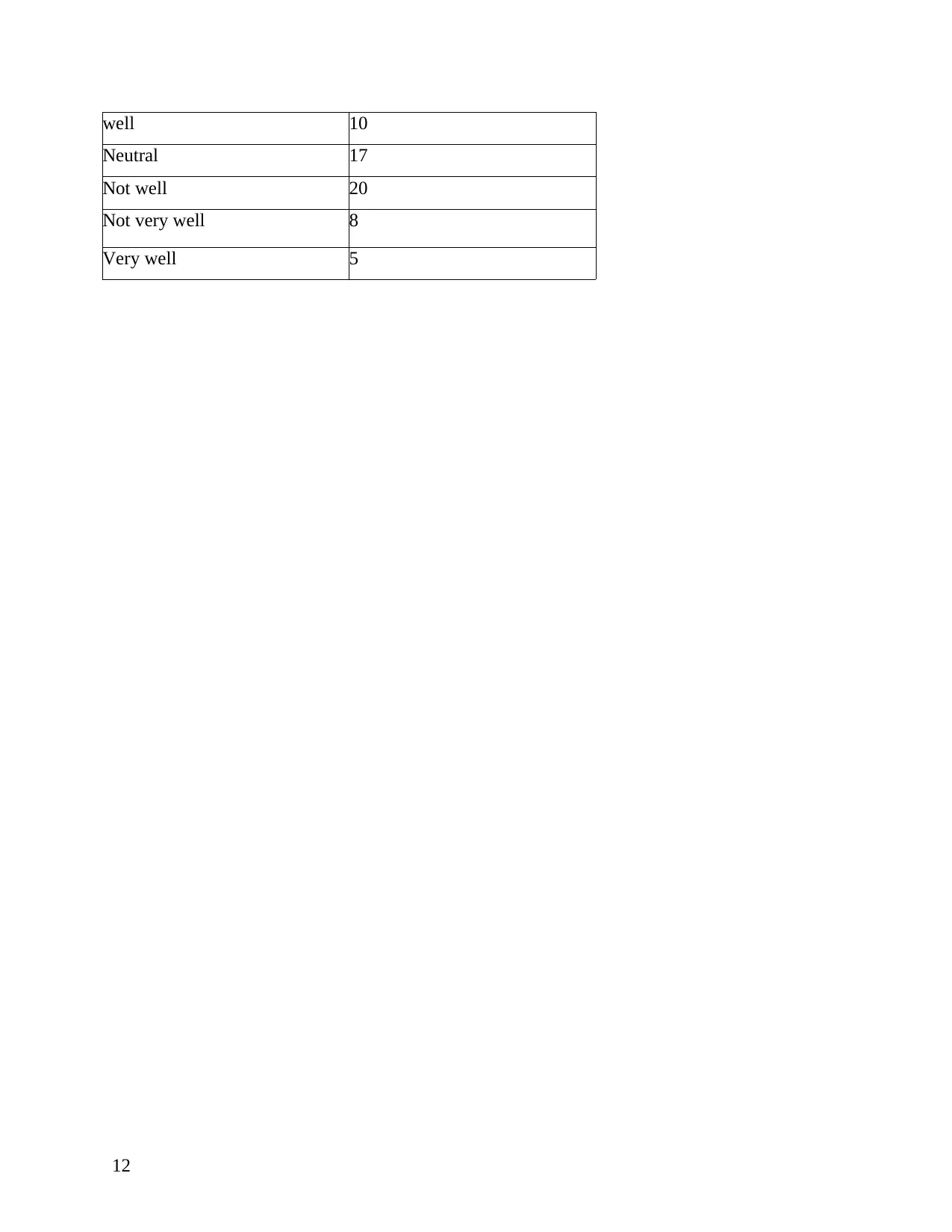
well 10
Neutral 17
Not well 20
Not very well 8
Very well 5
12
Neutral 17
Not well 20
Not very well 8
Very well 5
12
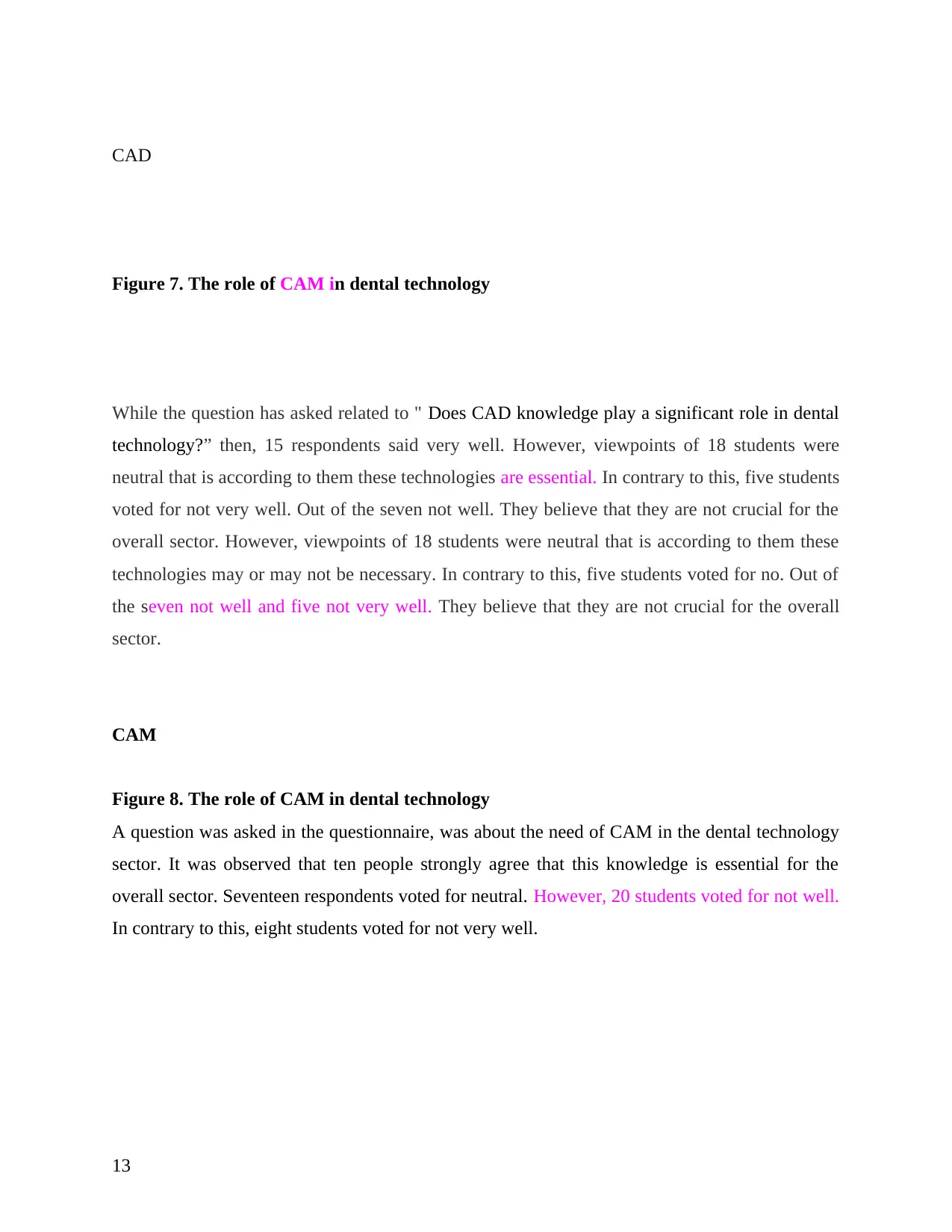
CAD
Figure 7. The role of CAM in dental technology
While the question has asked related to " Does CAD knowledge play a significant role in dental
technology?” then, 15 respondents said very well. However, viewpoints of 18 students were
neutral that is according to them these technologies are essential. In contrary to this, five students
voted for not very well. Out of the seven not well. They believe that they are not crucial for the
overall sector. However, viewpoints of 18 students were neutral that is according to them these
technologies may or may not be necessary. In contrary to this, five students voted for no. Out of
the seven not well and five not very well. They believe that they are not crucial for the overall
sector.
CAM
Figure 8. The role of CAM in dental technology
A question was asked in the questionnaire, was about the need of CAM in the dental technology
sector. It was observed that ten people strongly agree that this knowledge is essential for the
overall sector. Seventeen respondents voted for neutral. However, 20 students voted for not well.
In contrary to this, eight students voted for not very well.
13
Figure 7. The role of CAM in dental technology
While the question has asked related to " Does CAD knowledge play a significant role in dental
technology?” then, 15 respondents said very well. However, viewpoints of 18 students were
neutral that is according to them these technologies are essential. In contrary to this, five students
voted for not very well. Out of the seven not well. They believe that they are not crucial for the
overall sector. However, viewpoints of 18 students were neutral that is according to them these
technologies may or may not be necessary. In contrary to this, five students voted for no. Out of
the seven not well and five not very well. They believe that they are not crucial for the overall
sector.
CAM
Figure 8. The role of CAM in dental technology
A question was asked in the questionnaire, was about the need of CAM in the dental technology
sector. It was observed that ten people strongly agree that this knowledge is essential for the
overall sector. Seventeen respondents voted for neutral. However, 20 students voted for not well.
In contrary to this, eight students voted for not very well.
13
Paraphrase This Document
Need a fresh take? Get an instant paraphrase of this document with our AI Paraphraser
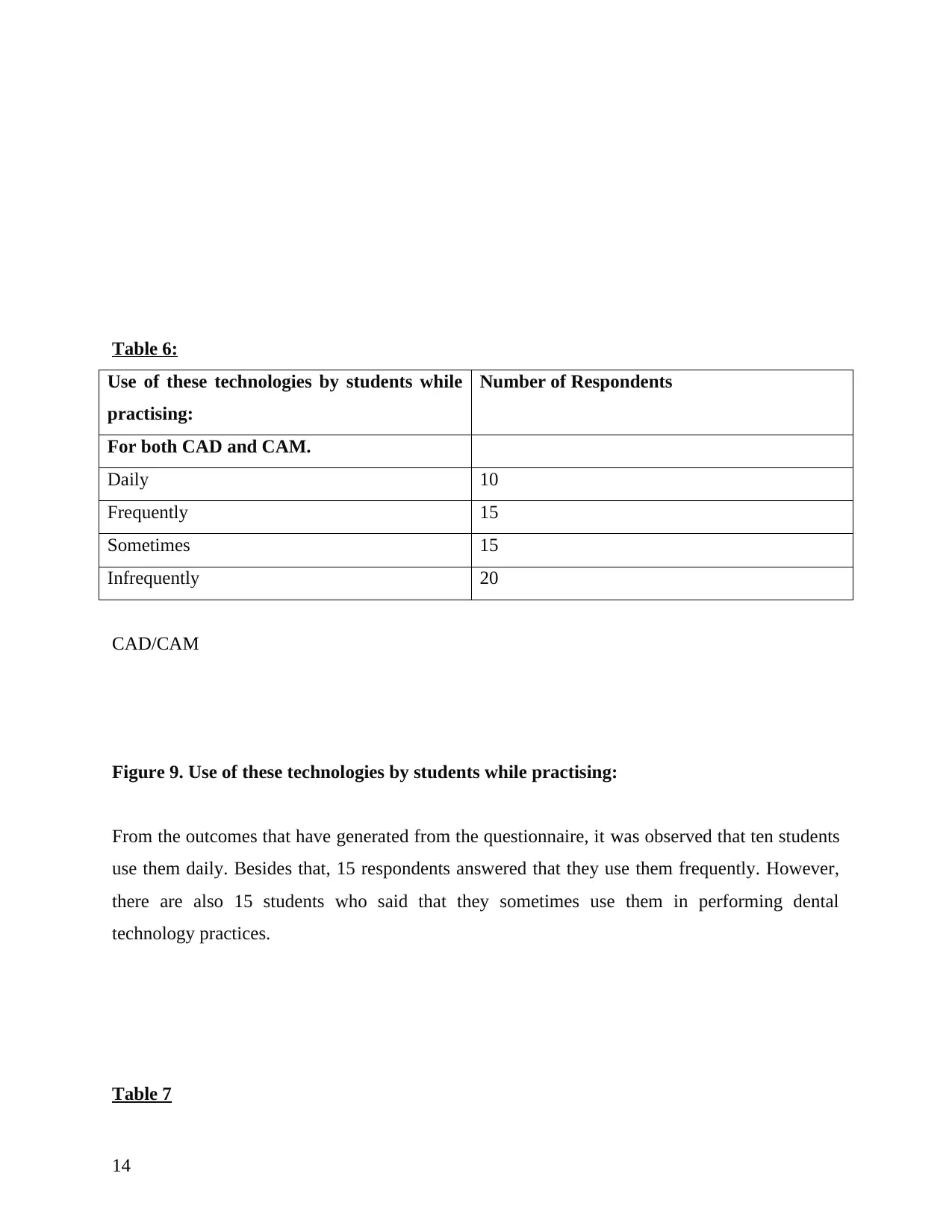
Table 6:
Use of these technologies by students while
practising:
Number of Respondents
For both CAD and CAM.
Daily 10
Frequently 15
Sometimes 15
Infrequently 20
CAD/CAM
Figure 9. Use of these technologies by students while practising:
From the outcomes that have generated from the questionnaire, it was observed that ten students
use them daily. Besides that, 15 respondents answered that they use them frequently. However,
there are also 15 students who said that they sometimes use them in performing dental
technology practices.
Table 7
14
Use of these technologies by students while
practising:
Number of Respondents
For both CAD and CAM.
Daily 10
Frequently 15
Sometimes 15
Infrequently 20
CAD/CAM
Figure 9. Use of these technologies by students while practising:
From the outcomes that have generated from the questionnaire, it was observed that ten students
use them daily. Besides that, 15 respondents answered that they use them frequently. However,
there are also 15 students who said that they sometimes use them in performing dental
technology practices.
Table 7
14
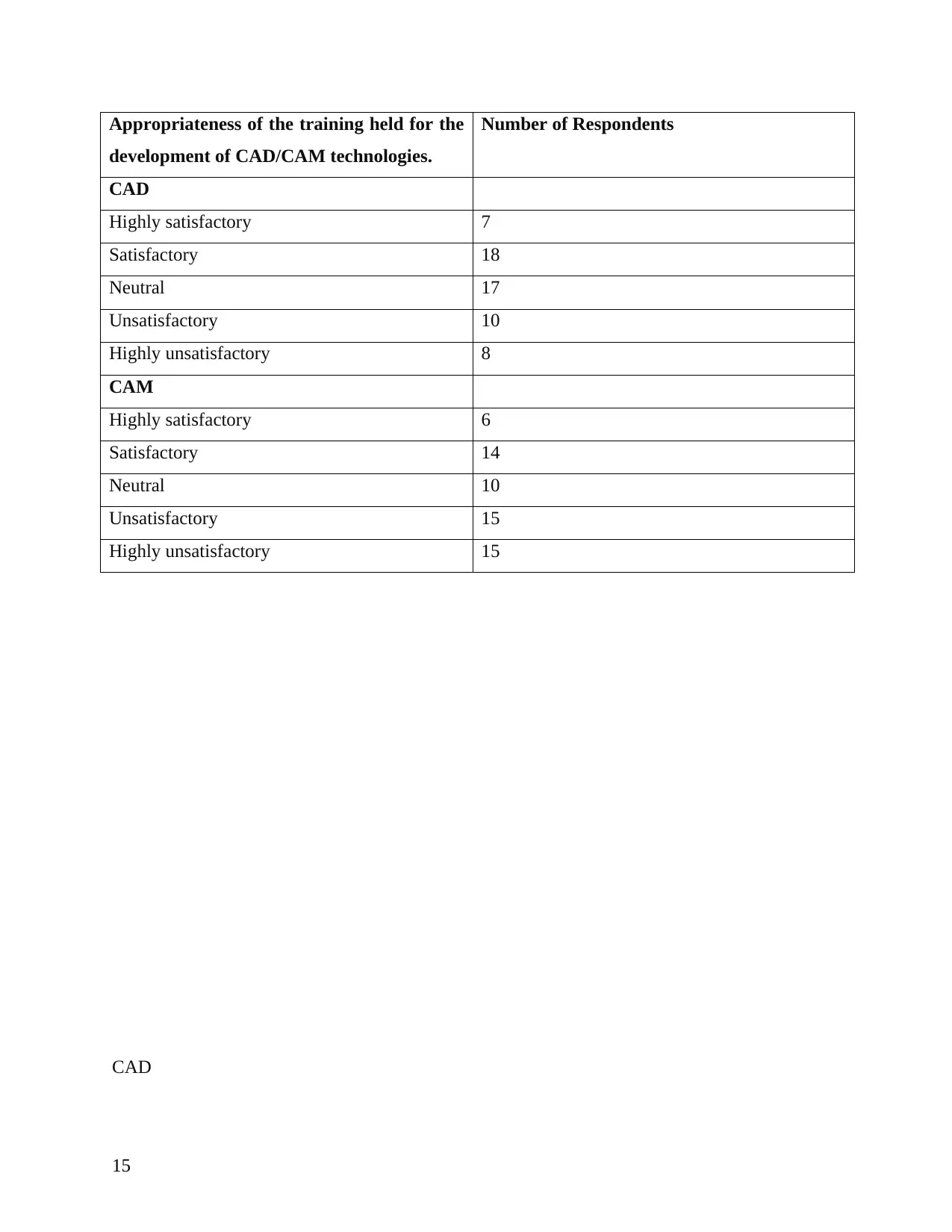
Appropriateness of the training held for the
development of CAD/CAM technologies.
Number of Respondents
CAD
Highly satisfactory 7
Satisfactory 18
Neutral 17
Unsatisfactory 10
Highly unsatisfactory 8
CAM
Highly satisfactory 6
Satisfactory 14
Neutral 10
Unsatisfactory 15
Highly unsatisfactory 15
CAD
15
development of CAD/CAM technologies.
Number of Respondents
CAD
Highly satisfactory 7
Satisfactory 18
Neutral 17
Unsatisfactory 10
Highly unsatisfactory 8
CAM
Highly satisfactory 6
Satisfactory 14
Neutral 10
Unsatisfactory 15
Highly unsatisfactory 15
CAD
15

Figure 10. Appropriateness of the training held for the development of CAD/CAM
technologies
From the questionnaire that conducted on a sample size of 60 students, it has observed that there
are only seven students who was highly satisfied with the appropriateness of the training that
conducted for the development of technologies. However, it should recognise that 18
respondents were satisfied with the training. Further, 17 people keep neutral attitude towards it,
in contrary to this, ten people was not satisfied with the training conducted forth CAD. In
addition to this, it has found that eight students were highly dissatisfied with the technical skills
provided by the university.
CAM
Figure 11. Appropriateness of the training held for the development of CAD/CAM
technologies.
It has observed that 15 students are highly satisfied with the CAM training that was conducted
for the development of technologies. Also, 14 respondents were satisfied with the training.
Further, ten people keep neutral attitude towards it. In contrary to this, 15 respondents are not
satisfied with the training conducted for CAM. In addition to this, it was founded that six
students were highly dissatisfied with the training held by the university.
16
technologies
From the questionnaire that conducted on a sample size of 60 students, it has observed that there
are only seven students who was highly satisfied with the appropriateness of the training that
conducted for the development of technologies. However, it should recognise that 18
respondents were satisfied with the training. Further, 17 people keep neutral attitude towards it,
in contrary to this, ten people was not satisfied with the training conducted forth CAD. In
addition to this, it has found that eight students were highly dissatisfied with the technical skills
provided by the university.
CAM
Figure 11. Appropriateness of the training held for the development of CAD/CAM
technologies.
It has observed that 15 students are highly satisfied with the CAM training that was conducted
for the development of technologies. Also, 14 respondents were satisfied with the training.
Further, ten people keep neutral attitude towards it. In contrary to this, 15 respondents are not
satisfied with the training conducted for CAM. In addition to this, it was founded that six
students were highly dissatisfied with the training held by the university.
16
Secure Best Marks with AI Grader
Need help grading? Try our AI Grader for instant feedback on your assignments.

Table 8:
How many hours training do they receive
over each year?
Number of Respondents
CAD
1 hour 11
2 hours 19
More than 3 hours 5
24 hours 25
CAM
1 hour 10
2 hours 20
More than 3 hours 10
24 hours 20
CAD
Figure 12. CAD/CAM training by the students
It is necessary for the students to attend the training. From the question that included in the
questionnaire, it was observed that five such students spend more than 3 hours for the training of
CAD. On the other hand, it has observed that 11 students spend 1 hour a year on this learning.
Furthermore, the highest among all of them is 25 who have spent a day for the training. Also, 19
students were trained for 2 hours.
17
How many hours training do they receive
over each year?
Number of Respondents
CAD
1 hour 11
2 hours 19
More than 3 hours 5
24 hours 25
CAM
1 hour 10
2 hours 20
More than 3 hours 10
24 hours 20
CAD
Figure 12. CAD/CAM training by the students
It is necessary for the students to attend the training. From the question that included in the
questionnaire, it was observed that five such students spend more than 3 hours for the training of
CAD. On the other hand, it has observed that 11 students spend 1 hour a year on this learning.
Furthermore, the highest among all of them is 25 who have spent a day for the training. Also, 19
students were trained for 2 hours.
17
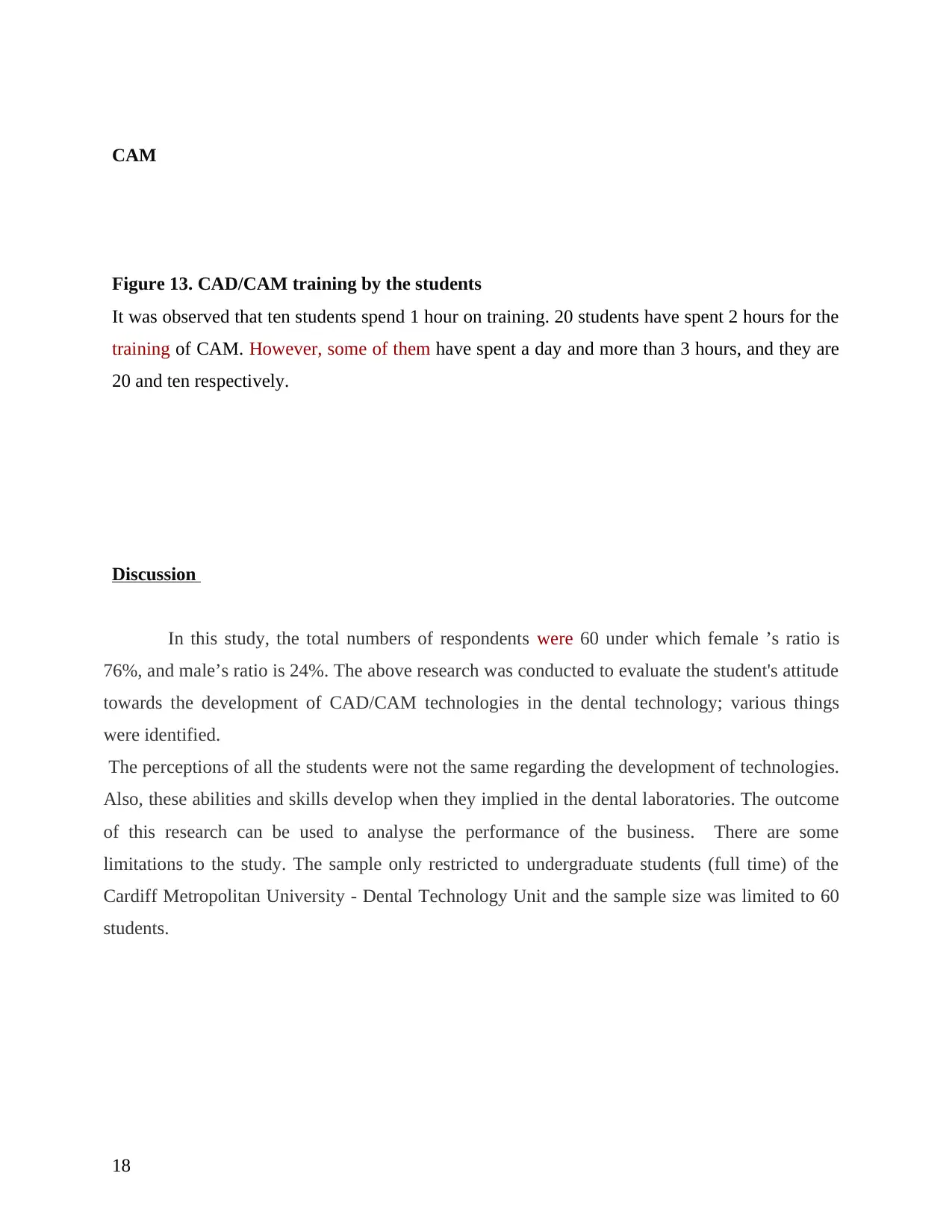
CAM
Figure 13. CAD/CAM training by the students
It was observed that ten students spend 1 hour on training. 20 students have spent 2 hours for the
training of CAM. However, some of them have spent a day and more than 3 hours, and they are
20 and ten respectively.
Discussion
In this study, the total numbers of respondents were 60 under which female ’s ratio is
76%, and male’s ratio is 24%. The above research was conducted to evaluate the student's attitude
towards the development of CAD/CAM technologies in the dental technology; various things
were identified.
The perceptions of all the students were not the same regarding the development of technologies.
Also, these abilities and skills develop when they implied in the dental laboratories. The outcome
of this research can be used to analyse the performance of the business. There are some
limitations to the study. The sample only restricted to undergraduate students (full time) of the
Cardiff Metropolitan University - Dental Technology Unit and the sample size was limited to 60
students.
18
Figure 13. CAD/CAM training by the students
It was observed that ten students spend 1 hour on training. 20 students have spent 2 hours for the
training of CAM. However, some of them have spent a day and more than 3 hours, and they are
20 and ten respectively.
Discussion
In this study, the total numbers of respondents were 60 under which female ’s ratio is
76%, and male’s ratio is 24%. The above research was conducted to evaluate the student's attitude
towards the development of CAD/CAM technologies in the dental technology; various things
were identified.
The perceptions of all the students were not the same regarding the development of technologies.
Also, these abilities and skills develop when they implied in the dental laboratories. The outcome
of this research can be used to analyse the performance of the business. There are some
limitations to the study. The sample only restricted to undergraduate students (full time) of the
Cardiff Metropolitan University - Dental Technology Unit and the sample size was limited to 60
students.
18

Conclusion
This study found that although the undergraduate students have different views towards the
application of CAD/CAM in dental technology if seen from a fundamental perspective, the
involvement of CAD/CAM can prove beneficial enough. From the outcomes, it can conclude
that CAD/CAM plays a significant role in dentistry and dental technology sector. CAD/CAM
was observed a successful implementation in the dentistry field because it has reduced the rate of
operations and processes to a considerable extent, thus saving much amount of time.
Moreover, the extent to which these technologies are being used in the dental universities and
dental technology laboratories analysed. The researcher believes that further studies need to
conduct with a broader population. The outcome of this research can be used to guide future
development in the use of CAD/CAM system in dental technology, and to encourage the
students learning.
Recommendations
19
This study found that although the undergraduate students have different views towards the
application of CAD/CAM in dental technology if seen from a fundamental perspective, the
involvement of CAD/CAM can prove beneficial enough. From the outcomes, it can conclude
that CAD/CAM plays a significant role in dentistry and dental technology sector. CAD/CAM
was observed a successful implementation in the dentistry field because it has reduced the rate of
operations and processes to a considerable extent, thus saving much amount of time.
Moreover, the extent to which these technologies are being used in the dental universities and
dental technology laboratories analysed. The researcher believes that further studies need to
conduct with a broader population. The outcome of this research can be used to guide future
development in the use of CAD/CAM system in dental technology, and to encourage the
students learning.
Recommendations
19
Paraphrase This Document
Need a fresh take? Get an instant paraphrase of this document with our AI Paraphraser

As some students are not giving any time for the learning of CAM, some training needs
to organise for them to explain the importance of CAM in dental technology.
Also, as 20 students were not happy and satisfied with the training held for the learning
of CAD/CAM technology, it should be ensured to reorganise the training session with
more skilled and advanced technologies.
20
to organise for them to explain the importance of CAM in dental technology.
Also, as 20 students were not happy and satisfied with the training held for the learning
of CAD/CAM technology, it should be ensured to reorganise the training session with
more skilled and advanced technologies.
20
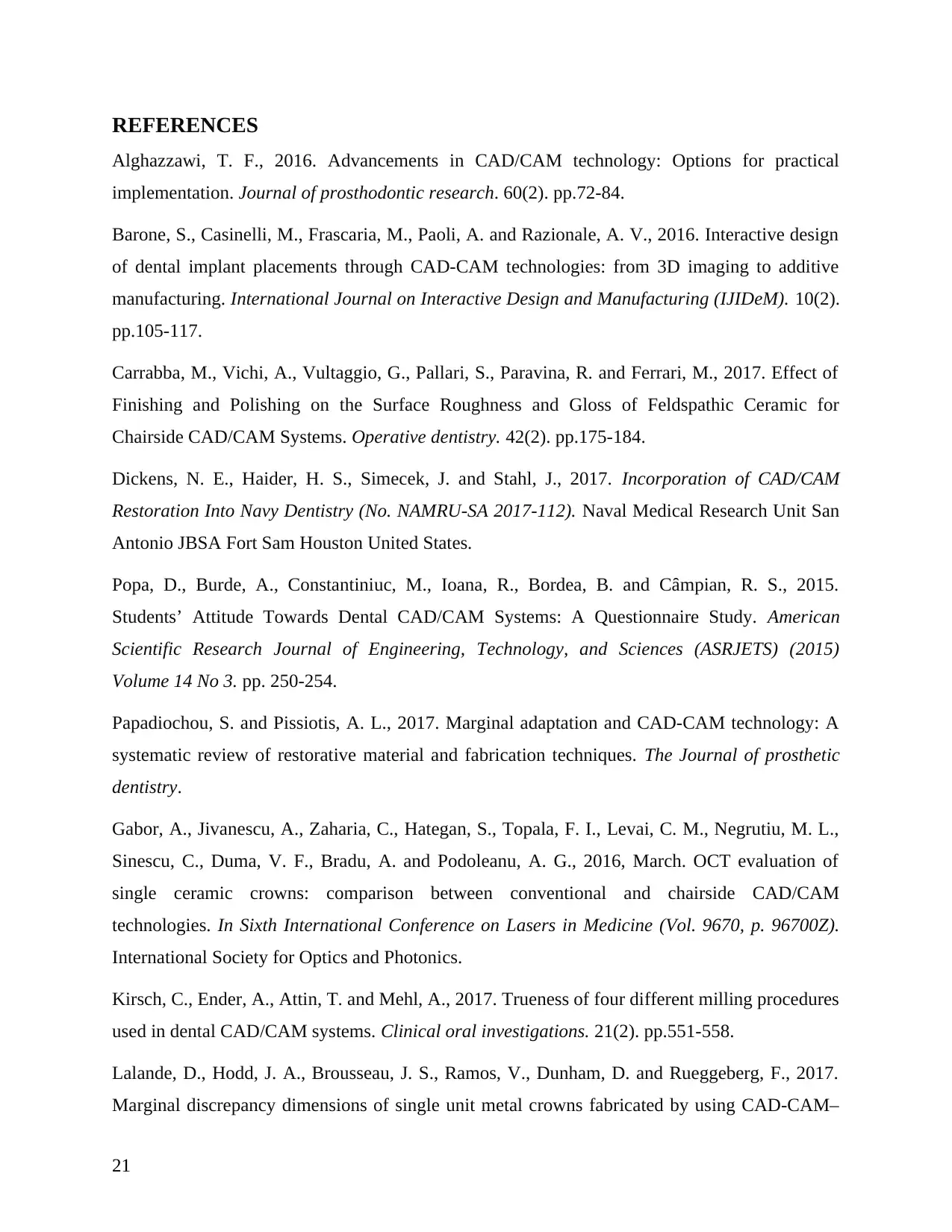
REFERENCES
Alghazzawi, T. F., 2016. Advancements in CAD/CAM technology: Options for practical
implementation. Journal of prosthodontic research. 60(2). pp.72-84.
Barone, S., Casinelli, M., Frascaria, M., Paoli, A. and Razionale, A. V., 2016. Interactive design
of dental implant placements through CAD-CAM technologies: from 3D imaging to additive
manufacturing. International Journal on Interactive Design and Manufacturing (IJIDeM). 10(2).
pp.105-117.
Carrabba, M., Vichi, A., Vultaggio, G., Pallari, S., Paravina, R. and Ferrari, M., 2017. Effect of
Finishing and Polishing on the Surface Roughness and Gloss of Feldspathic Ceramic for
Chairside CAD/CAM Systems. Operative dentistry. 42(2). pp.175-184.
Dickens, N. E., Haider, H. S., Simecek, J. and Stahl, J., 2017. Incorporation of CAD/CAM
Restoration Into Navy Dentistry (No. NAMRU-SA 2017-112). Naval Medical Research Unit San
Antonio JBSA Fort Sam Houston United States.
Popa, D., Burde, A., Constantiniuc, M., Ioana, R., Bordea, B. and Cȃmpian, R. S., 2015.
Students’ Attitude Towards Dental CAD/CAM Systems: A Questionnaire Study. American
Scientific Research Journal of Engineering, Technology, and Sciences (ASRJETS) (2015)
Volume 14 No 3. pp. 250-254.
Papadiochou, S. and Pissiotis, A. L., 2017. Marginal adaptation and CAD-CAM technology: A
systematic review of restorative material and fabrication techniques. The Journal of prosthetic
dentistry.
Gabor, A., Jivanescu, A., Zaharia, C., Hategan, S., Topala, F. I., Levai, C. M., Negrutiu, M. L.,
Sinescu, C., Duma, V. F., Bradu, A. and Podoleanu, A. G., 2016, March. OCT evaluation of
single ceramic crowns: comparison between conventional and chairside CAD/CAM
technologies. In Sixth International Conference on Lasers in Medicine (Vol. 9670, p. 96700Z).
International Society for Optics and Photonics.
Kirsch, C., Ender, A., Attin, T. and Mehl, A., 2017. Trueness of four different milling procedures
used in dental CAD/CAM systems. Clinical oral investigations. 21(2). pp.551-558.
Lalande, D., Hodd, J. A., Brousseau, J. S., Ramos, V., Dunham, D. and Rueggeberg, F., 2017.
Marginal discrepancy dimensions of single unit metal crowns fabricated by using CAD-CAM–
21
Alghazzawi, T. F., 2016. Advancements in CAD/CAM technology: Options for practical
implementation. Journal of prosthodontic research. 60(2). pp.72-84.
Barone, S., Casinelli, M., Frascaria, M., Paoli, A. and Razionale, A. V., 2016. Interactive design
of dental implant placements through CAD-CAM technologies: from 3D imaging to additive
manufacturing. International Journal on Interactive Design and Manufacturing (IJIDeM). 10(2).
pp.105-117.
Carrabba, M., Vichi, A., Vultaggio, G., Pallari, S., Paravina, R. and Ferrari, M., 2017. Effect of
Finishing and Polishing on the Surface Roughness and Gloss of Feldspathic Ceramic for
Chairside CAD/CAM Systems. Operative dentistry. 42(2). pp.175-184.
Dickens, N. E., Haider, H. S., Simecek, J. and Stahl, J., 2017. Incorporation of CAD/CAM
Restoration Into Navy Dentistry (No. NAMRU-SA 2017-112). Naval Medical Research Unit San
Antonio JBSA Fort Sam Houston United States.
Popa, D., Burde, A., Constantiniuc, M., Ioana, R., Bordea, B. and Cȃmpian, R. S., 2015.
Students’ Attitude Towards Dental CAD/CAM Systems: A Questionnaire Study. American
Scientific Research Journal of Engineering, Technology, and Sciences (ASRJETS) (2015)
Volume 14 No 3. pp. 250-254.
Papadiochou, S. and Pissiotis, A. L., 2017. Marginal adaptation and CAD-CAM technology: A
systematic review of restorative material and fabrication techniques. The Journal of prosthetic
dentistry.
Gabor, A., Jivanescu, A., Zaharia, C., Hategan, S., Topala, F. I., Levai, C. M., Negrutiu, M. L.,
Sinescu, C., Duma, V. F., Bradu, A. and Podoleanu, A. G., 2016, March. OCT evaluation of
single ceramic crowns: comparison between conventional and chairside CAD/CAM
technologies. In Sixth International Conference on Lasers in Medicine (Vol. 9670, p. 96700Z).
International Society for Optics and Photonics.
Kirsch, C., Ender, A., Attin, T. and Mehl, A., 2017. Trueness of four different milling procedures
used in dental CAD/CAM systems. Clinical oral investigations. 21(2). pp.551-558.
Lalande, D., Hodd, J. A., Brousseau, J. S., Ramos, V., Dunham, D. and Rueggeberg, F., 2017.
Marginal discrepancy dimensions of single unit metal crowns fabricated by using CAD-CAM–
21
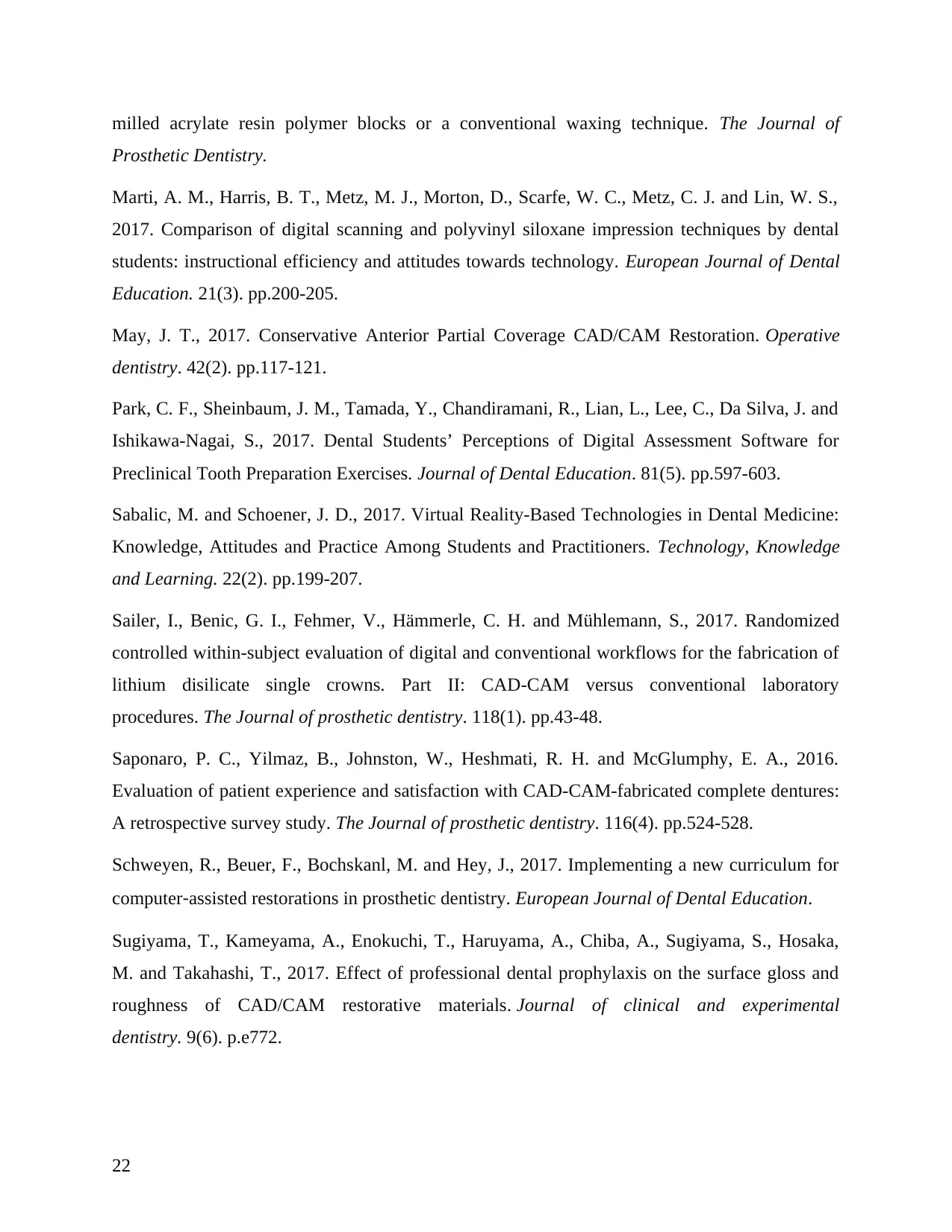
milled acrylate resin polymer blocks or a conventional waxing technique. The Journal of
Prosthetic Dentistry.
Marti, A. M., Harris, B. T., Metz, M. J., Morton, D., Scarfe, W. C., Metz, C. J. and Lin, W. S.,
2017. Comparison of digital scanning and polyvinyl siloxane impression techniques by dental
students: instructional efficiency and attitudes towards technology. European Journal of Dental
Education. 21(3). pp.200-205.
May, J. T., 2017. Conservative Anterior Partial Coverage CAD/CAM Restoration. Operative
dentistry. 42(2). pp.117-121.
Park, C. F., Sheinbaum, J. M., Tamada, Y., Chandiramani, R., Lian, L., Lee, C., Da Silva, J. and
Ishikawa-Nagai, S., 2017. Dental Students’ Perceptions of Digital Assessment Software for
Preclinical Tooth Preparation Exercises. Journal of Dental Education. 81(5). pp.597-603.
Sabalic, M. and Schoener, J. D., 2017. Virtual Reality-Based Technologies in Dental Medicine:
Knowledge, Attitudes and Practice Among Students and Practitioners. Technology, Knowledge
and Learning. 22(2). pp.199-207.
Sailer, I., Benic, G. I., Fehmer, V., Hämmerle, C. H. and Mühlemann, S., 2017. Randomized
controlled within-subject evaluation of digital and conventional workflows for the fabrication of
lithium disilicate single crowns. Part II: CAD-CAM versus conventional laboratory
procedures. The Journal of prosthetic dentistry. 118(1). pp.43-48.
Saponaro, P. C., Yilmaz, B., Johnston, W., Heshmati, R. H. and McGlumphy, E. A., 2016.
Evaluation of patient experience and satisfaction with CAD-CAM-fabricated complete dentures:
A retrospective survey study. The Journal of prosthetic dentistry. 116(4). pp.524-528.
Schweyen, R., Beuer, F., Bochskanl, M. and Hey, J., 2017. Implementing a new curriculum for
computer‐assisted restorations in prosthetic dentistry. European Journal of Dental Education.
Sugiyama, T., Kameyama, A., Enokuchi, T., Haruyama, A., Chiba, A., Sugiyama, S., Hosaka,
M. and Takahashi, T., 2017. Effect of professional dental prophylaxis on the surface gloss and
roughness of CAD/CAM restorative materials. Journal of clinical and experimental
dentistry. 9(6). p.e772.
22
Prosthetic Dentistry.
Marti, A. M., Harris, B. T., Metz, M. J., Morton, D., Scarfe, W. C., Metz, C. J. and Lin, W. S.,
2017. Comparison of digital scanning and polyvinyl siloxane impression techniques by dental
students: instructional efficiency and attitudes towards technology. European Journal of Dental
Education. 21(3). pp.200-205.
May, J. T., 2017. Conservative Anterior Partial Coverage CAD/CAM Restoration. Operative
dentistry. 42(2). pp.117-121.
Park, C. F., Sheinbaum, J. M., Tamada, Y., Chandiramani, R., Lian, L., Lee, C., Da Silva, J. and
Ishikawa-Nagai, S., 2017. Dental Students’ Perceptions of Digital Assessment Software for
Preclinical Tooth Preparation Exercises. Journal of Dental Education. 81(5). pp.597-603.
Sabalic, M. and Schoener, J. D., 2017. Virtual Reality-Based Technologies in Dental Medicine:
Knowledge, Attitudes and Practice Among Students and Practitioners. Technology, Knowledge
and Learning. 22(2). pp.199-207.
Sailer, I., Benic, G. I., Fehmer, V., Hämmerle, C. H. and Mühlemann, S., 2017. Randomized
controlled within-subject evaluation of digital and conventional workflows for the fabrication of
lithium disilicate single crowns. Part II: CAD-CAM versus conventional laboratory
procedures. The Journal of prosthetic dentistry. 118(1). pp.43-48.
Saponaro, P. C., Yilmaz, B., Johnston, W., Heshmati, R. H. and McGlumphy, E. A., 2016.
Evaluation of patient experience and satisfaction with CAD-CAM-fabricated complete dentures:
A retrospective survey study. The Journal of prosthetic dentistry. 116(4). pp.524-528.
Schweyen, R., Beuer, F., Bochskanl, M. and Hey, J., 2017. Implementing a new curriculum for
computer‐assisted restorations in prosthetic dentistry. European Journal of Dental Education.
Sugiyama, T., Kameyama, A., Enokuchi, T., Haruyama, A., Chiba, A., Sugiyama, S., Hosaka,
M. and Takahashi, T., 2017. Effect of professional dental prophylaxis on the surface gloss and
roughness of CAD/CAM restorative materials. Journal of clinical and experimental
dentistry. 9(6). p.e772.
22
Secure Best Marks with AI Grader
Need help grading? Try our AI Grader for instant feedback on your assignments.

Wolff, S., Oen, K. and Estafan, D., 2014. The Use of CAD/CAM Technology to Educate
Students in the Simulation Laboratory and in Clinical Settings. In Conference proceedings. The
future of education (p. 96). Libreria Universitaria. it Edizioni.
Zitzmann, N. U. and et. Al. Kovaltschuk, I., Lenherr, P., Dedem, P. and Joda, T., 2017. Dental
Students’ Perceptions of Digital and Conventional Impression Techniques: A Randomized
Controlled Trial. Journal of Dental Education. 81(10). pp.1227-1232.
23
Students in the Simulation Laboratory and in Clinical Settings. In Conference proceedings. The
future of education (p. 96). Libreria Universitaria. it Edizioni.
Zitzmann, N. U. and et. Al. Kovaltschuk, I., Lenherr, P., Dedem, P. and Joda, T., 2017. Dental
Students’ Perceptions of Digital and Conventional Impression Techniques: A Randomized
Controlled Trial. Journal of Dental Education. 81(10). pp.1227-1232.
23
1 out of 23
Your All-in-One AI-Powered Toolkit for Academic Success.
+13062052269
info@desklib.com
Available 24*7 on WhatsApp / Email
![[object Object]](/_next/static/media/star-bottom.7253800d.svg)
Unlock your academic potential
© 2024 | Zucol Services PVT LTD | All rights reserved.

